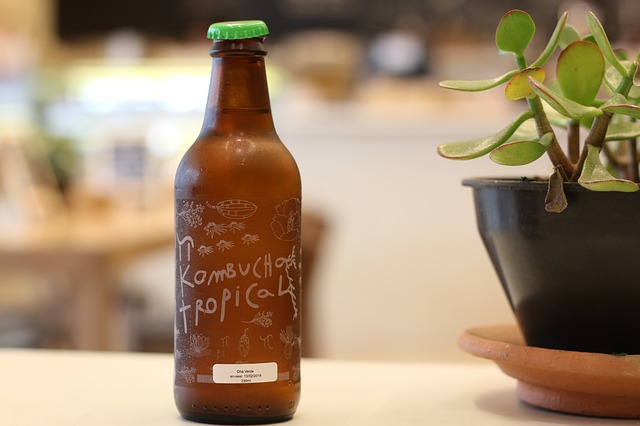Health, Historical
How to brew kombucha – fermentation at it’s easiest
How to brew kombucha – fermentation at it's easiest.
Here is some information on kombucha, which we hope will help you on your way to get started in the wonderful world of fermentation.
Kombucha is a lightly sparkling drink made from a solution of sweetened tea, the solution is fermented at room temperature with the addition of a “mother / scoby”, it is left open to the air but protected from flies or insects with a breathable cloth. The mother is a cellulose structure consisting of a combination of yeasts and bacteria, containing acetic bacteria (the same bacteria which produce acetic acid which ferments cider into cider vinegar, red wine into red wine vinegar etc.) *
It is important to use a wide mouthed jar or vessel (not plastic – as toxins can leach out of the plastic during the acidification of the drink) the width is also important as the mother needs oxygen during the fermentation process, so a large surface area is best (i.e. a glass Kilner jar or a wide mouth ceramic jar).
The fermentation process can take between 1-2 weeks for the solution to be ready to bottle, by that stage most of the sugar will be digested and your drink will be filled with beneficial acids and probiotics. The time is dependent on many things including temperature and air.
Probiotic is a general term for a range of different good bacteria, having many benefits for your body, the benefits are especially good for gut health, increasing the bacterial diversity in your gut which aids to a balanced microbial system.
Bacteria play the most important role in our body, we cannot survive without them, sadly our modern food production results in sterile food, void of any good bacteria. **
Things to be aware of, water quality is of major importance in the making of kombucha and for our general health, using naturally filtered water as opposed to chemically treated water will play a role on the bacteria and yeasts.
Although during the fermentation process there is a reduction in the amount of sugar and caffeine the end result does contains sugar and caffeine (unless you use herbal or caffeine free teas).
Ingredients:
Organic tea of choice
Optional additional herb or fruit of choice
Water – try to avoid chemically treated water, using natural spring water where possible
Organic sugar
Kombucha mother
Method:
1. Make a light tea of choice, allowing to infuse for at least 10 minutes.
2. Dissolve 6% (i.e. 60g per litre) sugar in the warm tea.
3. Allow liquid to cool to room temperature.
4. Place the liquid into a jar, preferred would be a wide mouthed glass Kilner style jar.
5. Place the kombucha mother on top of the liquid, and cover with a muslin cloth/paper towel fastened with a string or elastic band.
6. Keep at room temperature and taste daily to see how the flavour develops. ***
7. After 7-12 days you should have a slightly acidic flavour coming through, but with a little sweetness, this can take different times depending on temperature, activity of the mother, your environment etc.…
8. When you feel the flavour is where you want it, take out the mother, keeping it with a little of the liquid to cover it, then pour the liquid into glass bottles, (this is when you add any extra flavours to the booch such as ginger and lemon or hibiscus) capping tightly and leave out at room temperature for 3-4 days, this allows the kombucha to referment in the bottle creating a nice fizzy drink. Before opening the bottle, place it in the fridge until it is completely cold and open with care as it may be quite volatile.
9. Your mother is ready to use to make another kombucha or you can store in the fridge until you want to make another one (1-2 weeks should be fine) when you make your next kombucha add a little of the previous liquid to it and continue as above.
Our favourite summer flavours…
Green Tea, Nettle
White Tea, Lemon Verbena
Black Tea, Blackcurrant
***please note when tasting daily it is best to gently mix the solution around with a spoon (not wooden) as what is close to the mother will taste more acidic than what is at the bottom of the jar
***certain teas are best brewed at lower temperatures to maintain certain properties, check advised temperatures before brewing
* During the process the mother grows and produces another new layer on top of your original mother (please note that there can be a difference in growth levels between mothers, mainly due to tea quality and presence of caffeine)
** Making and consuming kombucha and other natural ferments from quality ingredients can greatly improve your overall health and immune system, mental and emotional health. Our bodies need a diversity of beneficial bacteria, introducing naturally fermented drinks and foods into your diet can help to remove toxins and encourage the all-important gut health.
For any further details feel free to contact Rose and Margaux via email on 4handsfoodstudio@protonmail.com or check them out on Instagram @4hands_food_studio




